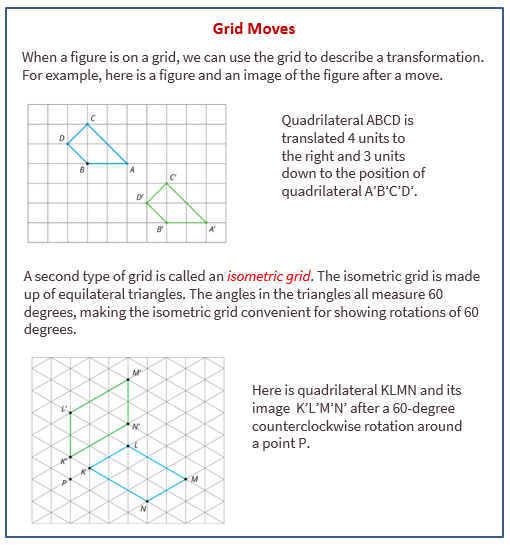Illustrative Mathematics Grade 8, Unit 1, Lesson 3: Grid Moves
Learning Targets:
- I can decide which type of transformations will work to move one figure to another.
- I can use grids to carry out transformations of figures.
Related Pages
Illustrative Math
Grade 7
Lesson 3: Grid Moves
Let’s transform some figures on grids.
Illustrative Math Unit 8.1, Lesson 3 (printable worksheets)
Lesson 3 Summary
The following diagram shows how to use grids to carry out transformations of figures.

Lesson 3.1 Notice and Wonder: The Isometric Grid
What do you notice? What do you wonder?
Lesson 3.2 Transformation Information
Follow the directions below each statement to tell GeoGebra how you want the figure to move. It is important to notice that GeoGebra uses vectors to show translations. A vector is a quantity that has magnitude (size) and direction. It is usually represented by an arrow.
These applets are sensitive to clicks. Be sure to make one quick click, otherwise it may count a double-click.
After each example, click the reset button, and then move the slider over for the next question.
Open Applet
- Translate triangle ABC so that A goes to A'.
a. Select the Vector tool.
b. Click on the original point A and then the new point A'. You should see a vector.
c. Select the Translate by Vector tool.
d. Click on the figure to translate, and then click on the vector. - Translate triangle ABC so that C goes to C'.
- Rotate triangle ABC 90° counterclockwise using center O.
a. Select the Rotate around Point tool.
b. Click on the figure to rotate, and then click on the center point.
c. A dialog box will open; type the angle by which to rotate and select the direction of rotation.
d. Click on ok.
Open Applet - Rotate quadrilateral ABCD 60° counterclockwise using center B.
- Rotate quadrilateral ABCD 60° clockwise using center C.
- Reflect quadrilateral ABCD using line l.
- Translate quadrilateral ABCD so that A goes to C.
Are you ready for more?
Try your own translations, reflections, and rotations.
- Make your own polygon to transform, and choose a transformation.
- Predict what will happen when you transform the image. Try it - were you right?
- Challenge your partner! Right click on any vectors or lines and uncheck Show Object. Can they guess what transformation you used?
Open Applet
Lesson 3 Practice Problems
- Apply each transformation described to Figure A. If you get stuck, try using tracing paper.
a. A translation which takes P to P'
b. A counterclockwise rotation of A, using center P, of 60 degrees
c. A reflection of A across line l - Here is triangle ABC drawn on a grid.
On the grid, draw a rotation of triangle ABC, a translation of triangle ABC, and a reflection of triangle ABC. Describe clearly how each was done. - a. Draw the translated image of ABCDE so that vertex C moves to C'. Tracing paper may be useful.
b. Draw the reflected image of Pentagon ABCDE with line of reflection l. Tracing paper may be useful.
c. Draw the rotation of Pentagon ABCDE around C clockwise by an angle of 150 degrees. Tracing paper and a protractor may be useful.
The Open Up Resources math curriculum is free to download from the Open Up Resources website and is also available from Illustrative Mathematics.
Try the free Mathway calculator and
problem solver below to practice various math topics. Try the given examples, or type in your own
problem and check your answer with the step-by-step explanations.

We welcome your feedback, comments and questions about this site or page. Please submit your feedback or enquiries via our Feedback page.